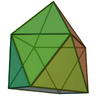Gyroelongated pyramid
| Set of gyroelongated pyramids | |
|---|---|
 Example pentagonal form | |
| Faces | 3n triangles 1 n-gon |
| Edges | 5n |
| Vertices | 2n+1 |
| Symmetry group | Cnv, [n], (*nn) |
| Rotational group | Cn, [n]+, (nn) |
| Dual polyhedron | ? |
| Properties | convex |
In geometry, the gyroelongated pyramids (also called augmented antiprisms) are an infinite set of polyhedra, constructed by adjoining an n-gonal pyramid to an n-gonal antiprism.
There are two gyroelongated pyramids that are Johnson solids made from regular triangles and square, and pentagons. A triangular and hexagonal form can be constructed with coplanar faces. Others can be constructed allowing for isosceles triangles.
Forms[]
| Image | Name | Faces |
|---|---|---|
 |
(Coplanar faces) |
9+1 triangles |
 |
Gyroelongated square pyramid (J10) | 12 triangles, 1 squares |
 |
Gyroelongated pentagonal pyramid (J11) | 15 triangles, 1 pentagon |
 |
(Coplanar faces) |
18 triangles, 1 hexagon |
See also[]
References[]
- Norman W. Johnson, "Convex Solids with Regular Faces", Canadian Journal of Mathematics, 18, 1966, pages 169–200. Contains the original enumeration of the 92 solids and the conjecture that there are no others.
- Victor A. Zalgaller (1969). Convex Polyhedra with Regular Faces. Consultants Bureau. No ISBN. The first proof that there are only 92 Johnson solids.
Categories:
- Pyramids and bipyramids
- Polyhedron stubs